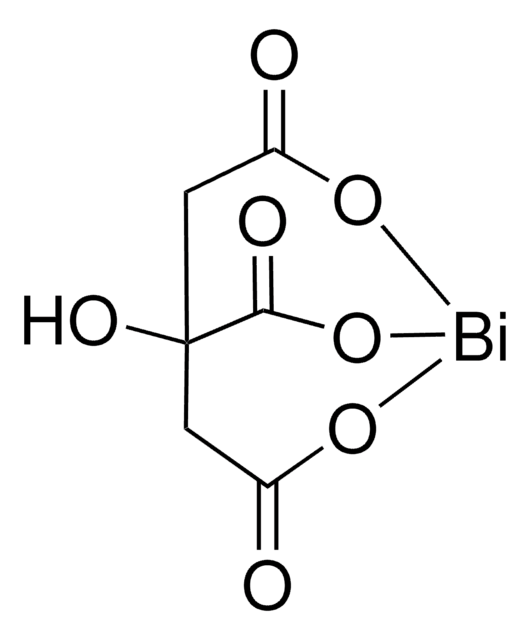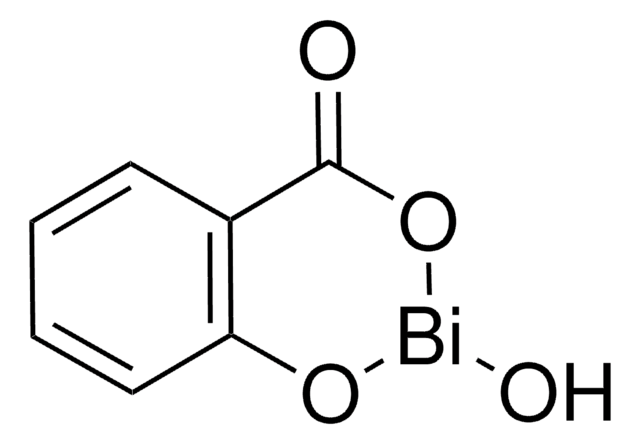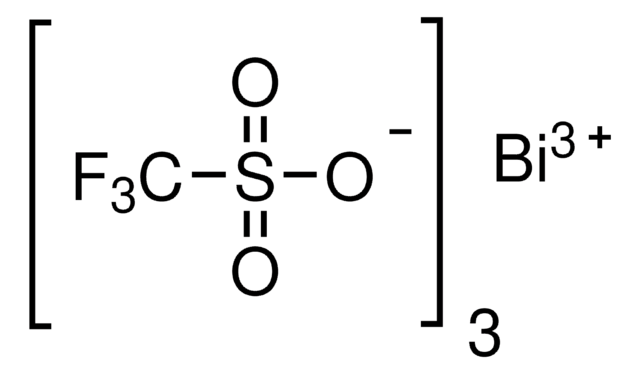480789
Bismuth(III) subsalicylate
99.9% trace metals basis
Synonym(s):
Bismuth oxysalicylate, Bismuth subsalicylate, Bismuth(III) salicylate basic
Sign Into View Organizational & Contract Pricing
All Photos(3)
About This Item
Linear Formula:
HOC6H4COOBiO
CAS Number:
Molecular Weight:
362.09
EC Number:
MDL number:
UNSPSC Code:
12161600
PubChem Substance ID:
NACRES:
NA.22
Recommended Products
Quality Level
Assay
99.9% trace metals basis
reaction suitability
core: bismuth
reagent type: catalyst
mp
>350 °C (lit.)
SMILES string
O[Bi]1OC(=O)c2ccccc2O1
InChI
1S/C7H6O3.Bi.H2O/c8-6-4-2-1-3-5(6)7(9)10;;/h1-4,8H,(H,9,10);;1H2/q;+3;/p-3
InChI key
ZREIPSZUJIFJNP-UHFFFAOYSA-K
General description
Bismuth(III) subsalicylate (BSS) is mainly used in bismuth-based medicines for treating gastrointestinal disorders and diarrhea.
Application
- Use of ferric chloride to identify salicylate-containing poisons.: This study explores the use of ferric chloride to detect salicylate compounds, including Bismuth subsalicylate, highlighting its significance in toxicological screenings and emergency treatments. (Hoffman RJ et al., 2002).
- Effect of pepper and bismuth subsalicylate on gastric pain and surface hydrophobicity in the rat.: Investigates the effects of Bismuth subsalicylate on gastric pain and stomach lining properties, providing insights into its gastroprotective mechanisms. (Lichtenberger LM et al., 1998).
- The coccoid forms of Helicobacter pylori. Criteria for their viability.: Examines the effectiveness of Bismuth subsalicylate in targeting different morphological forms of Helicobacter pylori, contributing to its role in eradication therapies. (Bode G et al., 1993).
- Bismuth therapy in gastrointestinal diseases.: A comprehensive review of the therapeutic applications of Bismuth subsalicylate in treating various gastrointestinal disorders, underscoring its pharmacological benefits and safety profile. (Gorbach SL, 1990).
Storage Class Code
11 - Combustible Solids
WGK
WGK 3
Flash Point(F)
Not applicable
Flash Point(C)
Not applicable
Personal Protective Equipment
dust mask type N95 (US), Eyeshields, Gloves
Choose from one of the most recent versions:
Already Own This Product?
Find documentation for the products that you have recently purchased in the Document Library.
Customers Also Viewed
D W Bierer
Reviews of infectious diseases, 12 Suppl 1, S3-S8 (1990-01-01)
Pepto-Bismol, which contains bismuth subsalicylate (BSS) as the active ingredient, has been marketed in the United States for more than 80 years. In the gastrointestinal tract, BSS is converted to salicylic acid and insoluble bismuth salts. The salicylate portion of
M D Manhart
Reviews of infectious diseases, 12 Suppl 1, S11-S15 (1990-01-01)
This report demonstrates that bismuth subsalicylate (BSS) effectively inhibits growth of a number of bacterial strains known to cause diarrhea, including Escherichia coli, Salmonella, Shigella, and Campylobacter. Other bismuth salts and sodium salicylate, a hydrolysis product of BSS in the
Copolymerizations of e-Caprolactone and Glycolide A Comparison of Tin (II) Octanoate and Bismuth (III) Subsalicylate as Initiators.
Kricheldorf HR and Rost S.
Biomolecules, 6(3), 1345-1352 (2005)
Abdurrahman Kadayifci et al.
The Turkish journal of gastroenterology : the official journal of Turkish Society of Gastroenterology, 23(1), 8-13 (2012-04-17)
Helicobacter pylori eradication rates with standard triple regimens are worsening, and alternative treatments are urgently needed in some populations. The present study aimed to compare the efficacy of bismuth-based quadruple and concomitant regimens. Consecutive Helicobacter pylori-positive patients with non-ulcer dyspepsia
David J McGee et al.
Antimicrobial agents and chemotherapy, 55(6), 2897-2904 (2011-04-06)
The human gastric pathogen Helicobacter pylori steals host cholesterol, modifies it by glycosylation, and incorporates the glycosylated cholesterol onto its surface via a cholesterol glucosyltransferase, encoded by cgt. The impact of cholesterol on H. pylori antimicrobial resistance is unknown. H.
Our team of scientists has experience in all areas of research including Life Science, Material Science, Chemical Synthesis, Chromatography, Analytical and many others.
Contact Technical Service










